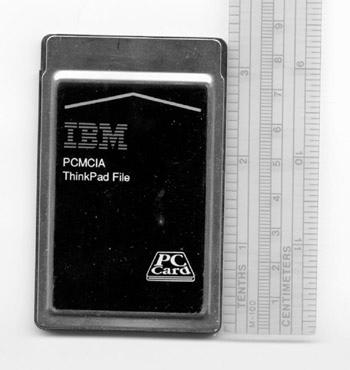The PC Card Standard
As Figure 24.1 shows, most PC Cards are 54 mm (2.126 inches) wide and 85.6 mm (3.37 inches) deep, with a 68-pin connector on one of the short edges. Some cards, especially those that contain wireless data network interfaces, AM/FM and TV tuners, or other types of radio transceivers, extend to about 115 mm (4.5 inches) deep, in order to allow the antenna inside the card to extend beyond the edge of the computer's case.

Figure 24.1: PC Cards are about the same size as a credit card.
The PC Card standard specifies three thicknesses (as shown in Figure 24.2): Type I (3.3 mm), Type II (5.0 mm), and Type III (10.5 mm). Type I is most often used for memory cards; Type II is the most common size for I/O cards and other network interfaces; and Type III is used almost exclusively for cards that contain rotating disk drives. All three types use the same 68-pin connector, so a Type III socket can accept all three types, and a Type II socket can accept both Type I and Type II.

Figure 24.2: From left to right: Type I, Type II, Type III, and an extended Type II card
| Note | Many laptops have Type II PC Card sockets, so they can use only Type I and Type II cards. Before you buy a disk drive on a Type III card, make sure your own laptop can accept it. |
Voltages
PC Cards take their electric power directly from the computer, through the PC Card socket. The connector inside a PC Card socket provides 3.3 volts and 5 volts on separate pins, so each card can use either voltage (or both). The designers of each PC Card choose the voltage they need for their particular design, so each card automatically draws the correct voltage.
CardBus Cards and slots
The original PC Card specification was limited to 16-bit connections and services. In 1995, an enhanced standard called CardBus was introduced for 32-bit hosts and applications. CardBus PC Cards always have a gold grounding strip on the top of the card, next to the 68-bit connector, often with eight small metal bumps across the strip. 16-bit PC Cards work in a CardBus socket, but older 16-bit sockets don't accept CardBus cards.
Just about every computer with a PC Card slot made after 1997 should support both 16-bit PC Cards and 32-bit CardBus Cards, so the difference between the two should not matter on a computer that can run Windows XP or Windows Vista. But if you're using an older laptop, it might not accept CardBus Cards-if you try to insert a 32-bit card into a CardBus slot, the card won't go all the way into the connector.
| Note | If you plan to install a PC Card socket in your desktop computer, make sure it supports CardBus cards. |
EAN: 2147483647
Pages: 372